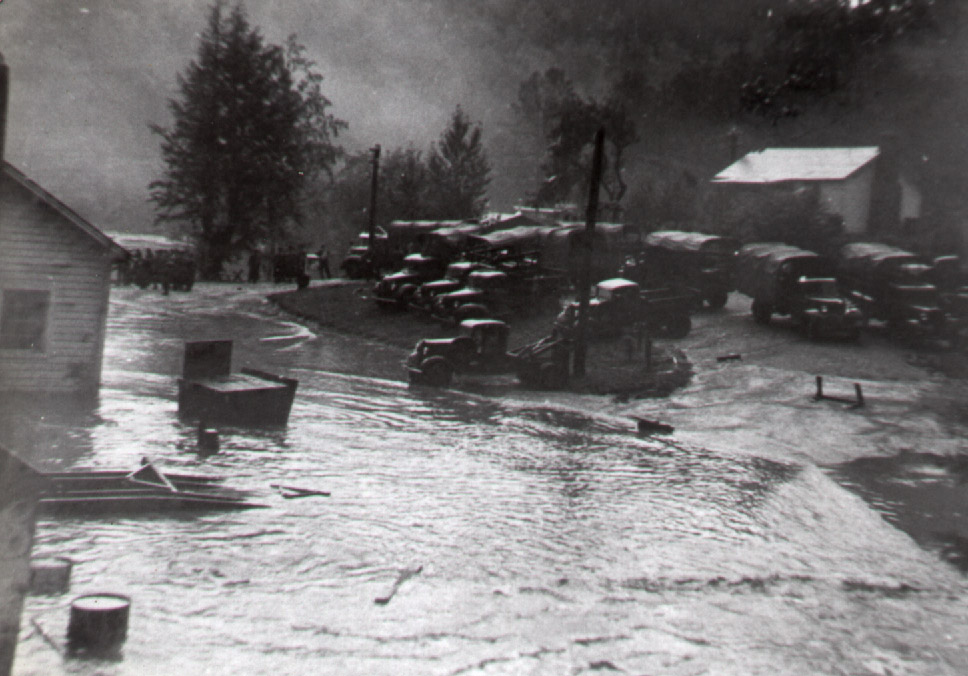North Carolina Ghost Town
You can still see part of the boiler room and a few intact boilers from the old cotton mill in Mortimer if you know where to look. There's also a white maintenance building built by the CCC during the 1930s, and some other CCC building foundations remain behind it. Today these silent remnants welcome hikers and campers at the entrance to the Mortimer campground in the Pisgah National Forest. What a story they hide!
Mortimer, NC had been built rapidly to house workers for the Ritter Lumber Company, which had bought the land for timber in 1904. Ritter Lumber Company's sawmill and a small textile mill provided jobs for the community's 800 residents. Substantial logging took place between Wilson and Steel Creeks, and the trees were hauled to the mill via Ritter's narrow gauge railroad, which followed Wilson Creek much of the way before ending in the village of Edgemont. The Hutton-Bourbannis Company operated various other narrow gauge logging railroad lines fanning out from Mortimer.
There was a company store, a blacksmith's shop, a church, a school, a hotel, and numerous houses. By 1906, the newly incorporated town even had a motion-picture facility and the Laurel Inn, which Teddy Roosevelt reportedly visited.  Then disaster struck. In 1916, a fire burned from Grandfather Mountain to Wilson Creek, and was immediately followed by a flood, which destroyed the logging railroad and the Lake Rhodhiss Dam, and devastated the Ritter Company's operations. The company left the town entirely about a year later. The flood is considered to be the worst in Caldwell County history.
Then disaster struck. In 1916, a fire burned from Grandfather Mountain to Wilson Creek, and was immediately followed by a flood, which destroyed the logging railroad and the Lake Rhodhiss Dam, and devastated the Ritter Company's operations. The company left the town entirely about a year later. The flood is considered to be the worst in Caldwell County history.
United Mills Company, a cotton mill, opened in 1922 and revitalized the town for a brief period. The Civilian Conservation Corps opened Camp F-5 at Mortimer during the Great Depression, and by 1933, had repaired many buildings damaged in the 1916 tribulations. In 1934, O.P. Lutz started a hosiery mill in the cotton mill buildings, but it never really succeeded. The Carolina & Northwestern Railway brought in mail every other day, but closed in 1938.
Then, on August 13, 1940, Wilson Creek jumped its banks again (this time prompted by a coastal hurricane.) The creek reached a flood stage of 94 feet and engulfed the town. This second flood, coming only 24 years after Mortimer's first horrific experience, was enough to drive most remaining families from the area.
The CCC hobbled along until the arrival of World War II in the 1940s. The railroad that used to run through Mortimer was taken up during WWII and melted down for the war effort. After the railroad was removed and the CCC left, the valley was left essentially unchanged for the next several decades.
Today, there are only about 16 permanent families living along the stream. Much of the mountain property in the northwestern part of Caldwell County is public land held by the U.S. Forest Service.
sources: www.ghosttowns.com/
www.tarheelpress.com/CNW5.html
www.mountaintimes.com/summer/auto_day_trips.php3
web.utk.edu/~jeparks/HDREdgemont.pdf
www.tarheelpress.com/blacksatchel.html
Related posts: "Appalachia's Katrina"
Originally posted at Appalachian History




1 comment:
I have been vacationing in the mortimer campground on Brown Mountain since I was a little kid. By brother and sister and I used to wait until dark and go up the short hill to the graveyard and mess around trying to scare each other. Now that I am older I am trying to find out some information on the graveyard. I have researched it on google and can't find anything. I've searched the flood as well for detailed information and that too is a deadend. I have heard that the bodies buried in the graveyard were washed out of ther graves when the flood came through, and were re-buried at the current location of the graveyard. I would love to know more on the history; especially the graveyard. If anyone can tell me anything I would reallt appreciate it. My email is jessemccall@embarqmail.com Than you so much.
Post a Comment